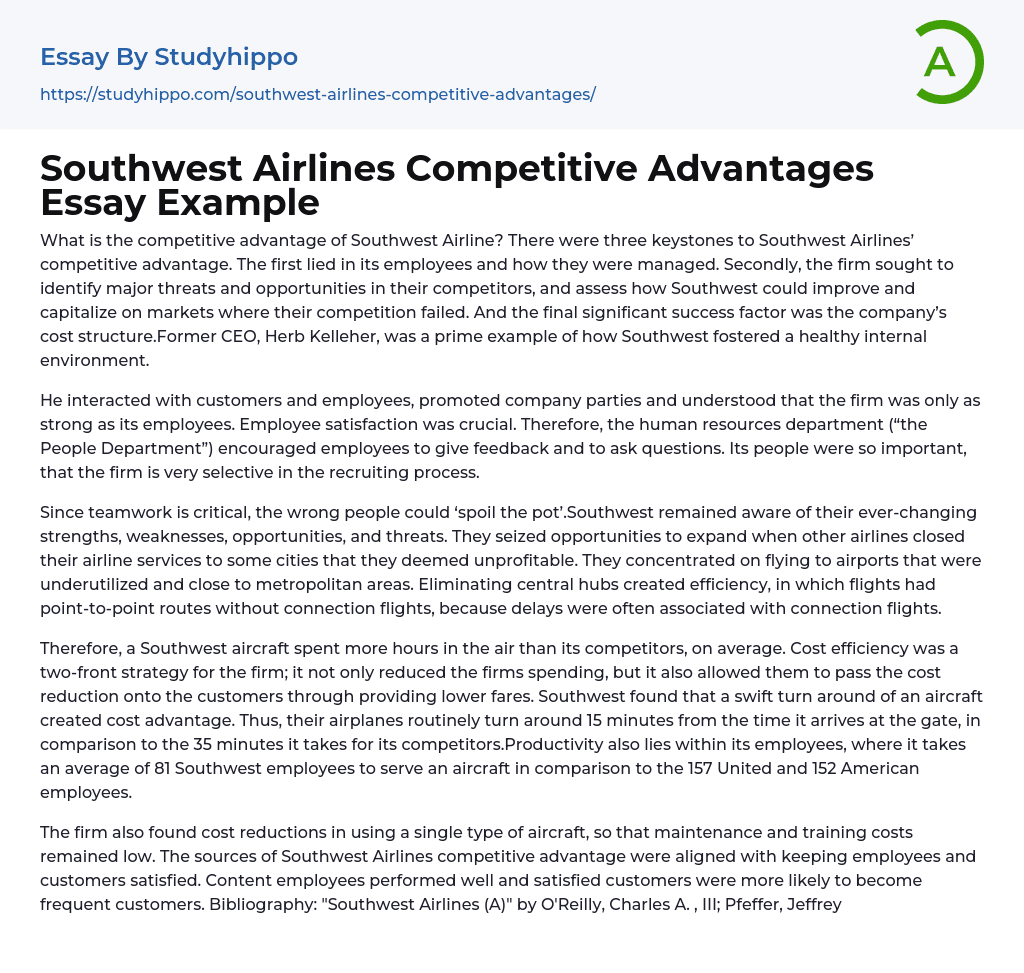What is the competitive advantage of Southwest Airline? There were three keystones to Southwest Airlines’ competitive advantage. The first lied in its employees and how they were managed. Secondly, the firm sought to identify major threats and opportunities in their competitors, and assess how Southwest could improve and capitalize on markets where their competition failed. And the final significant success factor was the company’s cost structure.Former CEO, Herb Kelleher, was a prime example of how Southwest fostered a healthy internal environment.
He interacted with customers and employees, promoted company parties and understood that the firm was only as strong as its employees. Employee satisfaction was crucial. Therefore, the human resources department (“the People Department”) encouraged employees to give feedback and to ask questions. Its people were so important, that the firm is very selective in the recruiting process.
>
Since teamwork is critical, the wrong people could ‘spoil the pot’.Southwest remained aware of their ever-changing strengths, weaknesses, opportunities, and threats. They seized opportunities to expand when other airlines closed their airline services to some cities that they deemed unprofitable. They concentrated on flying to airports that were underutilized and close to metropolitan areas. Eliminating central hubs created efficiency, in which flights had point-to-point routes without connection flights, because delays were often associated with connection flights.
Therefore, a Southwest aircraft spent more hours in the air than its competitors, on average. Cost efficiency was a two-front strategy for the firm; it not only reduced the firms spending, but it also allowed them to pass the cost reduction onto the customers through providing lower fares. Southwest found that a swift turn around of an aircraft created cost advantage. Thus
their airplanes routinely turn around 15 minutes from the time it arrives at the gate, in comparison to the 35 minutes it takes for its competitors.Productivity also lies within its employees, where it takes an average of 81 Southwest employees to serve an aircraft in comparison to the 157 United and 152 American employees.
The firm also found cost reductions in using a single type of aircraft, so that maintenance and training costs remained low. The sources of Southwest Airlines competitive advantage were aligned with keeping employees and customers satisfied. Content employees performed well and satisfied customers were more likely to become frequent customers. Bibliography: "Southwest Airlines (A)" by O'Reilly, Charles A. , III; Pfeffer, Jeffrey
- Chief Executive Officer essays
- Convenience Store essays
- Firm essays
- Training And Development essays
- Unilever essays
- Variable Cost essays
- Virgin Group essays
- Bargaining essays
- Entity essays
- Pest analysis essays
- Advertising essays
- Audience Theory essays
- Competitor Analysis essays
- Consumer essays
- Marketing Management essays
- Marketing Mix essays
- Marketing Plan essays
- Marketing Research essays
- Marketing Strategy essays
- Point Of Sale essays
- Price essays
- Procurement essays
- Product essays
- Product Differentiation essays
- Promotion essays
- Promotion And Marketing Communications essays
- Retailing essays
- Trademark essays
- Anheuser-busch essays
- Brands essays
- Detergent essays
- Product Placement essays
- Research Design essays
- New Product Development essays
- Advertisement essays
- Brand essays
- Sales Promotion essays
- Advertising campaign essays
- Consumer behaviour essays
- Offer And Acceptance essays
- Wal-Mart essays
- Discover essays
- John Locke essays
- 9/11 essays
- A Good Teacher essays
- A Healthy Diet essays
- A Modest Proposal essays
- A&P essays
- Academic Achievement essays
- Achievement essays




